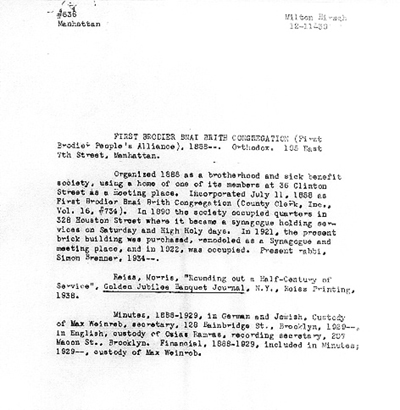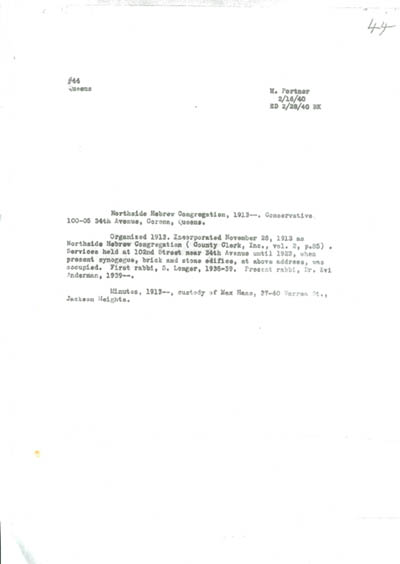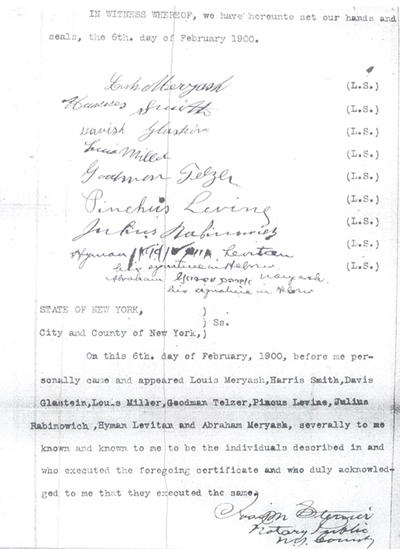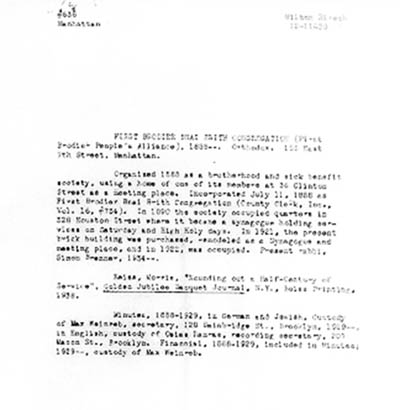This is an EXPANDED Introduction to a NYC Synagogue Database based upon the
1939 WPA Project cataloguing NYC Synagogues
This database is available for searching at the NYC Municipal Archives
Works Progress Administration (WPA) Federal
Writers Project
Survey of State and Local Historical Records
(1939)
Church Records Jewish - Synagogue
Introduction
by Ada Green and Judi Langer-Surnamer Caplan
In 1939 the Federal Writers' Project of the Works Progress Administration conducted a survey of all known houses of worship in the United States, both Jewish and non-Jewish. The synagogue listings for New York City are on five rolls of microfilm at the New York City Municipal Archives. They are Microfilm #'s (M.N.) 21318-21322, Roll #'s 319-323. Each synagogue filled out a Synagogue Records Form containing 14 questions. Two examples of this form are shown below.
The synagogues, divided separately by borough, are listed in the accompanying table in the same order that they appear on the appropriate microfilm(s) for their borough. Each entry contains both a Form # beginning with the letter "W" (in the upper left-hand corner of the form) and a Card # (in the upper right-hand corner of the form). In the two paired sets of examples below the first Form # is W-160 and the Card # is 636, and the second Form # is W-33 and the Card # is 44. The year of organization is also given.
If the letter "D" should appear next to the year that means the synagogue was defunct at the time that the survey was conducted in 1939. Lots of synagogues became defunct many years before 1939. A number of them continued to exist as landsmanshaftn though. An example of this is Anshei Raguler (Chevra Anshe Rogale), for the town of Ariogala, Lithuania, which was organized in 1898, but whose 1939 survey form says was disbanded about 15 years earlier due to lack of membership and that it remains only as a society.
It is interesting to see that many societies that we always considered to be solely a landsmanshaft for our ancestral town started as a synagogue, although the opposite is also true, as in the case of the First Brodier Bnai Brith Congregation below, where the society began as a sick benefit society and then became a synagogue in order to keep the society members together. Question #13 indicates that many protocol or minute books for these societies existed at one time that unfortunately were not saved. This survey is an excellent source for the history of a landsmanshaft, in particular question #14. Many of the forms also indicate the cemetery or cemeteries where its burial plot is located, as in the case below.
There is also much other data to be learned from these Synagogue Records Survey Cards. Questions #5 through # 7 asked for the names of the rabbi(s) and officers of the congregation below, Question 9 dealt with the religious affiliation of the synagogue, if it had one, and at the bottom of the form, there was a place to write in the name of the person who filled out and provided the data.
The most important information contained on the survey form was later typed up by the organizers of this project on cards, with a separate card for each non-defunct synagogue. The cards themselves were also microfilmed and are included on the same rolls as the survey forms. For some boroughs they follow right before or right after the survey form, while for others they are clustered all together separately. No matter where the card appears on the microfilm, the Card # (which is on the upper left-hand corner of the card) is cross-referenced in the upper right-hand corner of the survey form for each non-defunct synagogue. The most useful piece of information on the card that was not in the survey form was the translation into English of the Hebrew or Yiddish name of the organization. This is listed in the "Alternate Names and English Translation" column of the accompanying table. Less than one-quarter of defunct synagogues contained a card, so there is no English translation for them. See below to see the corresponding typed cards to the survey forms for the First Brodier Bnai Brith Congregation and the Northside Hebrew Congregation.
[Note that this is a totally separate project than the WPA Yiddish Writers' Guild of the Federal Writers' Group survey of Jewish Landsmanschaften and Family Circles of New York, published by the I.L. Peretz Yiddish Writers' Group in 1938 and 1939, which contained a totally different questionnaire.]
The extraction of this New York City Synagogue section of the 1939 WPA Historical Records Survey of Synagogues and Churches was begun by Ada Green in 2000.
Since the first extraction did not include any addresses, and Judi Langer-Surnamer Caplan initially wanted to try to incorporate this data into a general NYC area synagogue database, and needed to know the addresses in order to determine which Temple Israel or Anshei Sepharad Nusach Ho Ari was which, she then volunteered to revisit the microfilmed records which are archived at the NYC Municipal Archives. Ada graciously e-mailed Judi a copy of her Excel file for her to use to record the addresses.
However, as Judi began reading through the various microfilmed records, she soon became entranced with many of the details, and decided to record not only the addresses of the many synagogues but also the names of the congregational rabbis as well as the details of the congregational histories, and even where available, the cemeteries where some of the synagogues then had burial plots.
Perusing the five rolls of this particular microfilm series has been a fascinating education in the ebbs and flows of the development, consolidation, and demise of the plethora of synagogues which had sprung up by 1939 in the five boroughs of New York City, in the Bronx, Brooklyn, Manhattan, Queens and Staten Island, which were in existence at that time.
Both of us enjoyed learning about the congregations that were started by women, or by Rabbis, or named for Rabbis, as well as the eye-opening wide range of possible shul names beyond the typical Temple Israel, Oheb Shalom, or Rodeph Shalom. There were congregations named: Linath Hazedek (Visitors of the Sick), Lechet Yashur (Walk Straight), Nefuzoth Jehudah (The Expansion of Judah), Tiphereth Mizrachi (Pride of the East), and Russian Painters Benevolent Association.
It was disheartening, though, especially when going through the separate enumeration of "defunct" Manhattan synagogues, to read all the entries of "Building demolished - no trace of synagogue" or "no such number" or that a used car lot, fish market, public library, playground, or a church was occupying the site of a former shul, or that a shul had passed out of existence due to the Great Depression or the construction of a major roadway such as the George Washington Bridge. While attempting to search for the Oestereicher Anshei Spharad Congregation on West 114th Street in Manhattan one 1939 WPA Researcher reported: "Jewish cleaning store proprietor who has been in this neighborhood for ... 30 years... bitterly bewailed the fact that whereas years ago, Jewish religion and culture flowered in this section and one used to pay $ 25.00 and $ 50.00 for a seat to hear such celebrities as Cantor Rosenblatt and Slossky during the High and Holy Days most of the synagogues were sold and converted into churches, the congregations disbanded or moved, the Jews fled to different locations."
One favorite description of a congregation is from the write-up for Beth Hakenesseth Anshei Mieletz: "Composed of a mixed element from the standpoint of age - ranging from 21 up to heaven." And the prize for the best purpose or mission statement for a shul is connected to this statement in the write-up of the Wall Street Shul on Maiden Lane: "Synagogue organized by Judge Benjamin E. Greenspan in 1929 for the purpose to help business people of Wall St., not to forget the Almighty God and to remember they are only human beings."
The Fields in this database include:
Form #
The WPA Project apparently used a standardized pre-printed form sent to the synagogues to be filled out by them. Some synagogues filled out everything copiously, while others left some or all areas blank.
Card #
Being a government project, each card had to a number, and the "W" probably stood for Works Project. The number on the card correlated two or more series of files on a given religious institution.
Roll #
The roll number refers to the microfilm reel the data is on in the cabinet drawer at the New York City Municipal Archives.
Year Organized
This was the year the synagogue or religious institution was organized and founded according to their records or according to their incorporation papers.
Name of Organization
The name by which the synagogue was known, usually in Hebrew, but occasionally in English, is listed first.
Alternate Names and English Translation
Other names by which the religious body was known, and the translation of this name as supplied by the synagogue or by the WPA Researcher are listed here.
Street Number and Street
These two separate fields provide the synagogue's current known address or last known address at the time of the survey.
Location in Borough
This mostly applies more to the boroughs of Queens, and Staten Island, where specific neighborhoods, such as Astoria and Corona, or New Brighton and Port Richmond, were sometimes supplied on the card, and not the other three boroughs (Manhattan, Bronx, and Brooklyn).
Borough
There are five boroughs in New York City: Manhattan (New York County), Bronx, Brooklyn (Kings County), Queens, and Staten Island (Richmond County).
Comments
There are numerous and diverse other details that might show up (but not necessarily for every institution) in the Comments section including:
- sources of information
- rabbinical education and training of rabbis
- consolidation and/or dissolution of synagogues and minyanim
- physical appearance of buildings
- names of rabbis who have served the congregation (first, current, and other rabbis)
- the passing of rabbis - sometimes even with the date of death
- cemeteries where the synagogue had burial plots at the time of the WPA survey.
- full and detailed histories of the synagogue, including former addresses
However, the following data was not usually extracted for this database: names of officers and their addresses, the records then available circa 1939 at each synagogue, affiliation (Orthodox, Conservative, Reform, and Unaffiliated), journals, histories, or books about the synagogues.
We all owe a great debt to the hard-working, dedicated people who were the field researchers involved in this WPA project surveying New York City synagogues back in the late 1930s and early 1940s, including - Harold Albaum, Joe Eisinger, Samuel Gerson, William Gubin, Milton Hirsch, Bernard Kasper, Elsie Katz, Ellis Kramer, Morris Levine, M. Portner, Doris Radzyner, William Rubin, Celia Rogow, Beatrice Schwartz, Max Simon, Harry Sohn, Yakov Tarle, and Helen Zuckerman - without whose valiant efforts we would not have the wealth of material we now have today to draw upon in this database.
  |
 |
 |
 |
 |
 |
Rabbi Langer listed in 1939 WPA Synagogue Survey
[Since Judi's father was a rabbi in the NYC area circa 1939-1941, she was not sure if she would find him listed or not. As it turned out, Rabbi Samuel Langer was on one of the survey cards turned in, listed above as the first rabbi of a congregation, Northside Hebrew Congregation, in Queens.]
